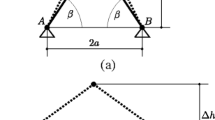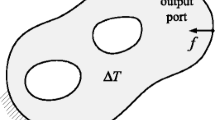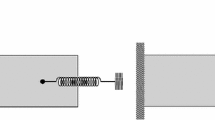Abstract
Thermoelectric actuators are a type of thermal actuator that generates motion through the input of thermal energy by thermoelectric devices. Thermoelectric actuators utilize thermal expansion and contraction effects, achieved by heating and cooling appropriate parts of the mechanism, which enables specified motions to be carried out and can provide quicker response times than those of typical thermal compliant mechanisms that rely on thermal expansion effects alone. However, the need to consider both thermal expansion and contraction effects makes the design process more complex. This paper proposes a topology optimization method, especially appropriate for the conceptual design of thermoelectric actuators, that uses a level set function to represent structural shape profiles so that optimized configurations have clear structural boundaries. Several numerical examples of thermoelectric actuator design problems are presented to confirm the effectiveness and utility of the proposed method.














Similar content being viewed by others
References
Allaire G, Jouve F, Toader AM (2004) Structural optimization using sensitivity analysis and a level-set method. J Comput Phys 194(1):363–393
Bendsøe MP, Kikuchi N (1988) Generating optimal topologies in structural design using a homogenization method. Comput Methods Appl Mech Eng 71(2):197–224
Bruns TE, Tortorelli DA (2001) Topology optimization of non-linear elastic structures and compliant mechanisms. Comput Methods Appl Mech Eng 190(26):3443–3459
Chu J, Zhang R, Chen Z (2011) A novel su-8 electrothermal microgripper based on the type synthesis of the kinematic chain method and the stiffness matrix method. J Micromech Microeng 21(5):054–030
Deaton JD, Grandhi RV (2014) A survey of structural and multidisciplinary continuum topology optimization: post 2000. Struct Multidisc Optim 49(1):1–38
AR Díaz, Kikuchi N (1992) Solutions to shape and topology eigenvalue optimization problems using a homogenization method. Int J Numer Meth Eng 35(7):1487–1502
Errico RM (1997) What is an adjoint model?. Bull Am Meteorogical Soc 78(11):2577–2591
Gao T, Zhang W, Zhu J, Xu Y, Bassir D (2008) Topology optimization of heat conduction problem involving design-dependent heat load effect. Finite Elem Anal Des 44(14):805–813
Isakari H, Kuriyama K, Harada S, Yamada T, Takahashi T, Matsumoto T (2014) A topology optimisation for three-dimensional acoustics with the level set method and the fast multipole boundary element method. J Mech Eng 1(4):CM0039–CM0039
Jeang A (2008) Combined parameter and tolerance design for quality via computer experiment: a design for thermoelectric microactuator. Electron Packag Manuf 31(3):192–201
Kobayashi M, Nishiwaki S, Izui K, Yoshimura M (2009) An innovative design method for compliant mechanisms combining structural optimisations and designer creativity. J Eng Design 20(2):125–154
Li J, Ananthasuresh G (2001) A quality study on the excimer laser micromachining of electro-thermal-compliant micro devices. J Micromech Microeng 11(1):38
Li Q, Steven GP, Querin OM, Xie Y (1999) Shape and topology design for heat conduction by evolutionary structural optimization. Int J Heat Mass Trans 42(17):3361–3371
Noguchi Y, Yamada T, Otomori M, Izui K, Nishiwaki S (2015) An acoustic metasurface design for wave motion conversion of longitudinal waves to transverse waves using topology optimization. Appl Phys Lett 107 (22):221,909
Otomori M, Yamada T, Izui K, Nishiwaki S (2015) Matlab code for a level set-based topology optimization method using a reaction diffusion equation. Struct Multidisc Optim 51(5):1159–1172
Pedersen CB, Buhl T, Sigmund O (2001) Topology synthesis of large-displacement compliant mechanisms. Int J Numer Meth Eng 50(12):2683–2705
Pérez-Aparicio JL, Taylor R, Gavela D (2007) Finite element analysis of nonlinear fully coupled thermoelectric materials. Comput Mechs 40(1):35–45
Prasanna S, Spearing SM (2007) Materials selection and design of microelectrothermal bimaterial actuators. J Microelectromech Syst 16(2):248–259
Riffat SB, Ma X (2003) Thermoelectrics: a review of present and potential applications. Appl Therm Eng 23(8):913–935
Rubio WM, Silva ECN, Nishiwaki S (2007) Piezoresistive sensor design using topology optimization. Struct Multidisc Optim 36(6):571–583
Seelecke S, Muller I (2004) Shape memory alloy actuators in smart structures: Modeling and simulation. Appl Mech Rev 57(1):23–46
Shakoor RI, Bazaz SA, Kraft M, Lai Y, Ul Hassan MM (2009) Thermal actuation based 3-dof non-resonant microgyroscope using metalmumps. Sens 9(4):2389–2414
Sigmund O (1997) On the design of compliant mechanisms using topology optimization*. J Struct Mech 25 (4):493–524
Sigmund O (2001) Design of multiphysics actuators using topology optimization–part i: One-material structures. Comput Methods Appl Mech Eng 190(49):6577–6604
Sigmund O, Maute K (2013) Topology optimization approaches. Struct Multidisc Optim 48(6):1031–1055
Suzuki K, Kikuchi N (1991) A homogenization method for shape and topology optimization. Comput Methods Appl Mech Eng 93(3):291–318
Wang MY, Wang X, Guo D (2003) A level set method for structural topology optimization. Comput Methods Appl Mech Eng 192(1):227–246
Yaji K, Yamada T, Yoshino M, Matsumoto T, Izui K, Nishiwaki S (2014) Topology optimization using the lattice Boltzmann method incorporating level set boundary expressions. J Comput Phys 274:158–181
Yamada T, Izui K, Nishiwaki S, Takezawa A (2010) A topology optimization method based on the level set method incorporating a fictitious interface energy. Comput Methos Appl Mech Eng 199(45-48):2876–2891
Yamada T, Izui K, Nishiwaki S (2011a) A level set-based topology optimization method for maximizing thermal diffusivity in problems including design-dependent effects. J Mech Eng 133(3):031,011
Yamada T, Yamasaki S, Nishiwaki S, Izui K, Yoshimura M (2011b) Design of compliant thermal actuators using structural optimization based on the level set method. J Comput Inf Sci Eng 11(1):011,005
Yin L, Ananthasuresh G (2002) A novel topology design scheme for the multi-physics problems of electro-thermally actuated compliant micromechanisms. Sens Actuators A 97:599–609
Author information
Authors and Affiliations
Corresponding author
Appendix: Sensitivity analysis
Appendix: Sensitivity analysis
In this Appendix, we provide the details of the sensitivity analysis. First, we note that the design sensitivity, \(\bar {F}^{\prime }\), is obtained as
We expand above equation as follows:
Based on the adjoint variable method (Errico 1997), the adjoint equations are now defined as follows:
where \(\tilde { {u}}\), \(\tilde {T}\), and \(\tilde {V}\) are the adjoint variables that respectively satisfy the above three equations. Consequently, the design sensitivity, \(\bar {F}^{\prime }\), is obtained as
where
Rights and permissions
About this article
Cite this article
Furuta, K., Izui, K., Yaji, K. et al. Level set-based topology optimization for the design of a peltier effect thermoelectric actuator. Struct Multidisc Optim 55, 1671–1683 (2017). https://doi.org/10.1007/s00158-016-1609-9
Received:
Revised:
Accepted:
Published:
Issue Date:
DOI: https://doi.org/10.1007/s00158-016-1609-9




